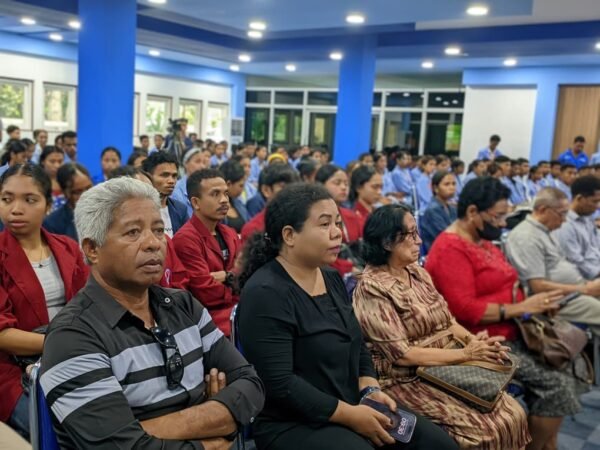Dili, September 13, 2025 (Média Democracia) – The National University of Timor-Lorosa’e (UNTL), through the Faculty of Social and Political Sciences (FCSP) and the Department of Social Communication, organized a student work exhibition to strengthen students’ knowledge and skills in public presentation on photojournalism, written reports, graphic design, video, seminars, and talk shows.
The chair of the student work exhibition organizing committee, Apolónia Nunes, said the objective of this activity was to showcase students’ work to the public, a work that they have produced during their classroom learning.
“The student work exhibition, which began in 2019 until today, has now been held five times. It has become a tradition for the Department of Social Communication at UNTL, providing an opportunity for students to present their creative works, both through field practice and to the public,” she told journalists at the FCS campus in Caicoli on Thursday (11/09).
The committee chair explained that the program consists of five components: first, photojournalism as well as graphic design for wall newspapers; second, a seminar; third, a talk show; fourth, competitions; and fifth, animation.
“In addition to the exhibition, this activity also aims to raise students’ awareness of how their knowledge can contribute to national development inside the country,” she said.
She emphasized that the activity was funded by student contributions, with each student contributing $2.50, and it also received support from Secoms, Silvia Dili, and UNTL Social Communication alumni.
At the event, Vice-Dean I for Academic Affairs of the Faculty of Social and Political Sciences, José da Costa Magno, expressed his gratitude to the lecturers who have trained students to be able to produce works.
“Today is a very important stage, we enjoy our own products, and we talk about competencies in education. These student works reflect competencies. People often say our production is the real truth, showing that theory and practice always go hand in hand. Without theory, it is difficult to discover good practice,” said the Vice-Dean.
He continued, explaining that works such as photography, scientific articles, and videos may seem like everyday activities, but in the future, they will be remembered and become part of history for individuals and society.
“In this Social Communication Department, we are already very strong because now we have two new PhDs, including one in linguistics. This shows the department has strong academic foundations,” he added.
The Vice-Dean also stressed, quoting Prime Minister Kay Rala Xanana Gusmão that now is the time to produce locally in order to reduce dependence on imports.
“I see that Social Communication has already started this path, students produce their own photos, capturing unique and difficult situations, and they make videos. I believe one day these will become part of history,” he said.
He affirmed that the faculty has a clear policy: each department must have a large hall of quality, in line with modern university standards.
Meanwhile, Secretary of State for Social Communication, Expedito Loro Dias Ximenes, considered the students’ works an important milestone for the future, preparing them to become good reporters in social communication institutions.
“In the world of photojournalism, they say a picture speaks a thousand words. But if we write a news text to publish in newspapers, radio, or television, the text might only take up half a page, containing only hundreds of words. But one photo in journalism can speak a thousand languages,” he explained.
Expedito emphasized that the government, through the Secretariat of State for Social Communication, will continue to support such works now and in the future.
Report: Domingas
Photo: Domingas

